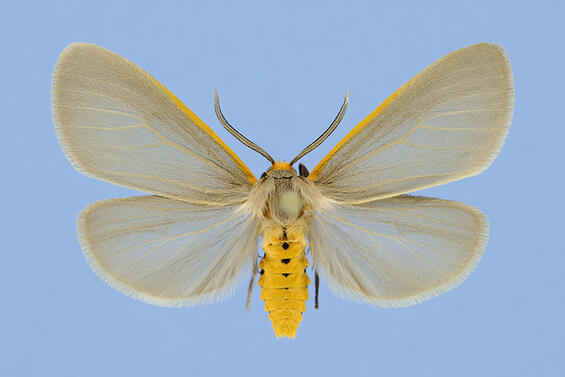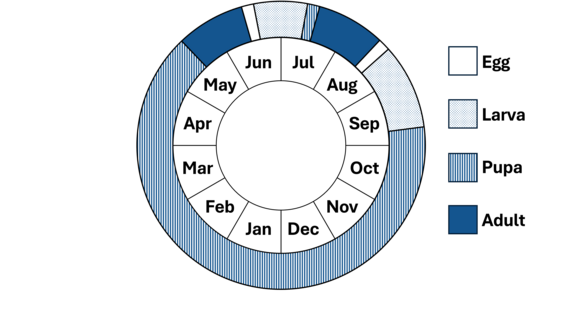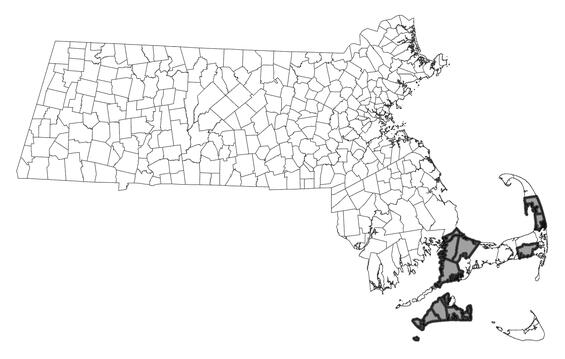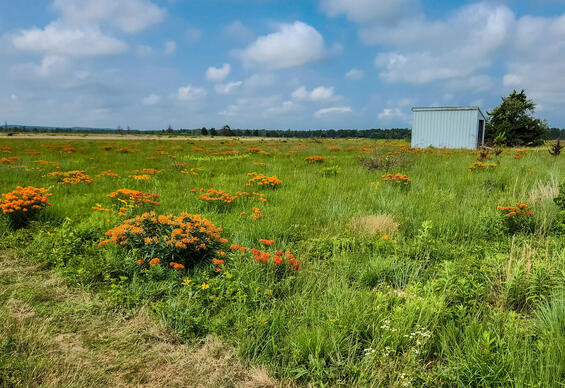- Scientific name: Cycnia collaris
- Species of Greatest Conservation Need (MA State Wildlife Action Plan)
- Threatened (MA Endangered Species Act)
Description

Collared cycnia moth, Cycnia collaris
The collared cycnia (Cycnia collaris) is an erebid moth with a wingspan of 28-36 mm (1.1-1.4 in) (Covell 1984). The forewing and hind wing are concolorous and without pattern, ranging from solid white with a hint of gray to solid gray. There is a bright yellow streak along the costa of the forewing, which does not fully extend to the wing apex, as it does in the similar delicate cycnia (Cycnia tenera). The head of the collared cycnia is the same bright yellow as the costa of the forewing, the thorax is concolorous with the white or gray wings, and the abdomen is bright yellow with a dorsal line of black dots. The caterpillar is bright orange in color, with tufts of gray setae (hairs) evenly distributed over the thorax and abdomen; it reaches a length of about 32 mm (1.3 in).
Life cycle and behavior

In Massachusetts, the collared cycnia moth has two broods, the first flying in late May and early June, the second flying in late July and early August. Eggs are laid on milkweeds (Asclepias); in Massachusetts, the preferred host plant is orange milkweed (Asclepias tuberosa). The bright orange color of the caterpillar matches the flowers of orange milkweed, providing camouflage when on the flowers. When on the foliage or stem of the host plant, the bright orange is a warning to potential predators — the caterpillar’s tissues sequester distasteful and poisonous cardenolides acquired from the host plant (Nishio 1981). The pupa overwinters in a cocoon made from setae plucked from the caterpillar’s own body, woven together with silk.
Distribution and abundance
The collared cycnia moth occurs from Massachusetts south to Florida, and west to South Dakota and Texas (Covell 1984). In Massachusetts, this species is restricted to Cape Cod and Martha’s Vineyard.

Distribution in Massachusetts.
1999-2024
Based on records in the Natural Heritage Database.
Habitat
In Massachusetts, the collared cycnia moth inhabits sandplain grasslands and heathlands.
Healthy habitats are vital for supporting native wildlife and plants. Explore habitats and learn about conservation and restoration in Massachusetts.

Sandplain grassland with orange milkweed (Asclepias tuberosa), habitat for the collared cycnia moth. Habitat managed by MassWildlife at Frances A. Crane Wildlife Management Area.
Threats
The collared cycnia moth is threatened by habitat loss and fire suppression in its disturbance-dependent habitats, specifically sandplain grasslands and heathlands. Other potential threats include invasive exotic plants, introduced generalist parasitoids, aerial insecticide spraying, non-target herbicide application, and off-road vehicles. The effect of a warming climate may not be detrimental to this species in Massachusetts; its range extends south to Florida, suggesting adaptation to warm temperatures. However, other aspects of climate change may be a threat — for example, many of the coastal habitats of this species are threatened by sea level rise.
Conservation
Land protection and habitat management are the primary conservation needs of this species in Massachusetts. In particular, sandplain grasslands and heathlands should be conserved, restored, and managed to maintain habitat for this species and other species dependent on such habitats.
Survey and monitoring
The distribution of the collared cycnia moth in Massachusetts is relatively well documented. Known populations of this species should be surveyed to document persistence at least once every 25 years; every 10 years is more desirable when practicable.
Management
Management of sandplain grasslands and heathlands benefits a suite of rare species, and habitat condition should be monitored and management adapted as needed. For the collared cycnia moth, sandplain grassland or heathland with orange milkweed (Asclepias tuberosa) is of particular importance.
Research needs
The natural history and conservation needs of the collared cycnia moth are relatively well known. However, the future effects of climate change on this species are unpredictable and should be documented.
References
Covell, C.V. 1984. A Field Guide to Moths of Eastern North America. Peterson Field Guide Series. Houghton Mifflin, Boston, Massachusetts. 496 pp.
Nishio, S. 1981. The fates and adaptive significance of cardenolides sequestered by larvae of Danaus plexippus (L.) and Cycnia inopinatus (Hy. Edwards). Dissertation Abstracts International 41(10): 3681-B.
Contact
| Date published: | March 21, 2025 |
|---|